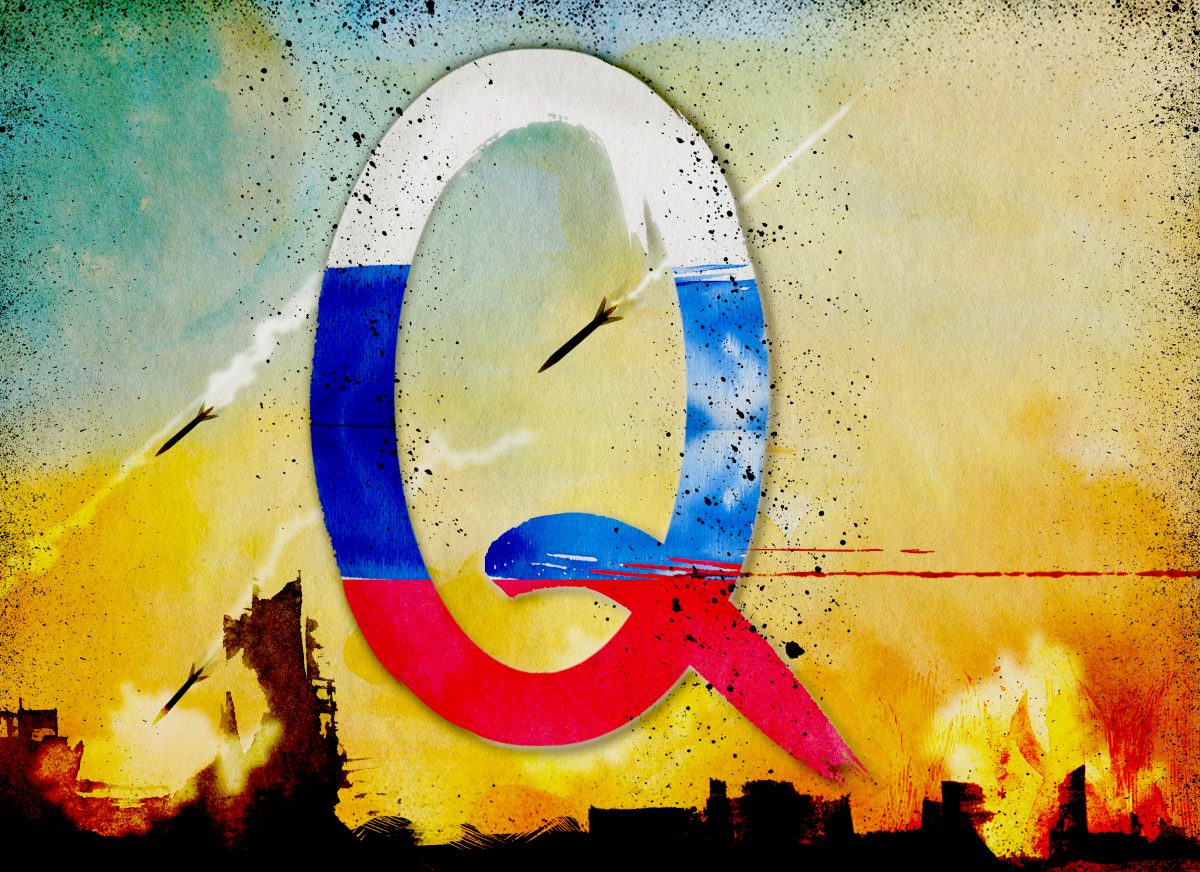The QAnon Timeline: Four Years, 5,000 Drops and Countless Failed Prophecies
QAnon is not a static conspiracy theory. Since it first emerged in 2017, it has continuously evolved, focusing on different key topics and adopting elements of other conspiracy theories. As Bellingcat has recently written, this elasticity has been the key to its success.
With the inauguration of US President Joe Biden, QAnon’s faithful are adrift and confused. Their distress has caused some observers to ask whether their cult may collapse entirely. That might be premature. Failed prophecies do not always collapse elaborate conspiracies — if that were true, how could QAnon have endured for four years?
If we cannot predict its end, we can at least trace QAnon from its beginning — looking at all the falsehoods and conspiracies it peddled, from the initial Mueller investigations to the era of COVID-19 and the last days of the Donald Trump presidency.

Supporters wearing shirts with the QAnon logo, chat before U.S. President Donald Trump takes the stage during his Make America Great Again rally in Wilkes-Barre, Pennsylvania, USA, August 2, 2018. Photo (c): Reuters / Leah Millis
Bellingcat researchers have analysed a dataset containing 4,952 so-called “Q drops”, the cryptic messages that are at the heart of the conspiracy theory. These were posted by an anonymous person known simply as “Q” — whom followers believe to be a source of insider knowledge about US politics. Whenever a Q drop appears, believers around the world eagerly try to interpret its hidden meaning, connecting them to real world events.
The Q drop dataset was found on the image board 8kun, which was used by Q followers as a location to comment on Q drops. It contains posts dating back to October 2017, a time when QAnon theories were a fringe online hobby, and continues until October 2020 — by which time they were taken all too seriously.
The word clouds in the timeline show the most common words found in the Q drops over one- or three-month intervals, while the accompanying text discusses important developments during these periods, both in US politics and significant Q drops.
This chronology brings quantitative and qualitative analysis to the story of QAnon’s growth, enriching our understanding of how the conspiracy adapts to contradictions and evolves its narratives.
Methodology
This investigation illustrates key developments and discussions in the QAnon conspiracy theory over time. To identify these trends, we split the data into subsets of one to three month intervals with an average of 290 Q drops.
For each subset, we ran a clustering algorithm that grouped sentences with a similar sentiment together. Using the results of the clustering, we then summarised major topics and notable developments for each time period.
“Sentiment” was evaluated using the Universal Sentence Encoder, an academically recognised text classification model that converted each Q drop into an array of numbers — a vector — based on its meaning.
Q drops with similar meanings have similar vectors. The closeness of two vectors can be calculated by taking their dot product. Thus we were able to evaluate the “closeness” in sentiment between sentences in order to categorise the text of each Q drop.
Pre-QAnon (2016)
Something of a precursor to QAnon can be found in Pizzagate — the false theory that Hillary Clinton operated a child sex-trafficking ring out of the basement of a pizza restaurant. Pizzagate, too, inspired serious followers who vowed to take action. One was Edgar Maddison Welch from North Carolina, who was arrested on December 4, 2016 for firing an assault rifle at the Washington D.C. pizza restaurant which was alleged to be the location of the crimes.
Welch’s arrest helped to debunk the conspiracy. But from the ashes of Pizzagate emerged QAnon. This new conspiracy theory replaced the Achilles’ heel of Pizzagate — its specificity — with ambiguity and adaptability. FBIAnon, a self-described high-level government analyst who was ostensibly the central source of information in the Pizzagate conspiracy, was replaced with Q, a supposed high-ranking intelligence officer with classified information on a supposed global cabal. As QAnon became an umbrella conspiracy theory, many others collected under its shade. Pizzagate lived on, in another form.
The first documented Q drop appeared on October 28, 2017 under the /pol/ sub board of 4chan, the “politically incorrect” and anonymous image board notorious for its grotesque content and memes.
October 2017
17 Q drops
This month’s drops all appeared over a four day period. These drops were attributed to Q through their tripcode, a unique identifier on 4chan that proves a series of anonymous posts were written by the same person or people.
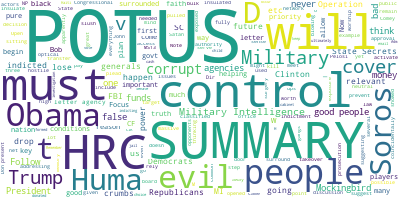
From the first two words of the drop (“HRC extradition”), it is clear that QAnon was recycling an idea from Pizzagate — that Hillary Clinton was a member of child sex trafficking cabal. The next seventeen drops established Donald Trump’s role in the theory, as the central hero bent on exposing the cabal, and introduced “Operation Mockingbird,” an alleged plot by mainstream media to hide the global elites’ Satanic crimes through fake news.
Notably, many of the initial Q drops are phrased as a series of questions, generating engagement and participation from followers of the conspiracy theory.
The most-mentioned topics in these drops were Hillary Clinton, POTUS (Donald Trump), the aforementioned “Operation Mockingbird”, the philanthropist George Soros, and Huma (Huma Mahmood Abedin, former deputy chief of staff to Hillary Clinton).
November 2017
223 Q drops
The following month, Q’s activity surged. The majority of these drops expanded upon previous theories about Hillary Clinton, adding to the cast of characters with conspiracy theories involving Huma (Clinton’s political aid during the 2016 campaign), Barack Obama, Iran, and Saudi Arabia.

“Antifa,” a term which has since become widespread in American politics, appeared in a Q drop on October 30, 2017. This was Q’s first use of the term.
On November 4, Q first uses the millenarian term “the great awakening” — when the supposed cabal will be toppled and justice restored. It will become one of the conspiracy’s most recognisable slogans.
Furthermore, “Alice and Wonderland,” code for “Hillary Clinton and Saudi Arabia,” began to appear in Q drops. This links to a conspiracy which alleged that Barack Obama and Hillary Clinton were beholden to Saudi interests, in particular Prince Al-Waleed bin Talal, a Saudi prince and businessman to whom both owed money. Another emerging conspiracy theory alleged that the Obama administration had secretly assisted the governments of Iran and North Korea to develop their nuclear weapons programs.
Once again, Huma and Hillary Clinton were the most mentioned subjects in these drops, followed by Saudi Arabia, Barack Obama, Al-Waleed Bin Talal, nuclear weapons, Iran, North Korea, Speaker of the House of Representatives Nancy Pelosi and former National Security Advisor Michael Flynn.
December 2017
219 Q drops
At the end of 2017, John McCain took his place alongside Hillary Clinton and Barack Obama in QAnon’s cast of villains. Some of the month’s Q drops alleged that he had connections to terrorist groups, the Free Syrian Army, and Saudi Arabia.
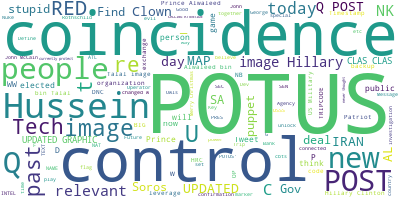
The QAnon community was excited by the possibility of further external validation — a government press release entitled “United States Sanctions Human Rights Abusers and Bad Actors Across the Globe” was believed to be authored by Q.
The same month, it became known from the press that Barack Obama — whom QAnon believers referred to by his middle name Hussein — had taken the secret service code name “renegade”. For followers of the conspiracy this was appropriate, as they increasingly accused the former president of betraying the US.
But alongside its focus on supposedly corrupt individuals, the conspiracy began to evolve to target entire organisations. This month saw several attacks on the Red Cross, whose offices in Haiti are believed by QAnon followers to be a hotspot for child trafficking.
January 2018
200 Q drops
This month, the QAnon community asserted that Donald Trump had surreptitiously addressed them via Twitter. The “evidence” for this was supposedly that Trump had misspelled a Tweet, correcting the word “consentual” to “consequential”. The 8kun imageboard brimmed with discussions about the added letter “q”. A later Q drop then affirmed the community’s connection to Trump.
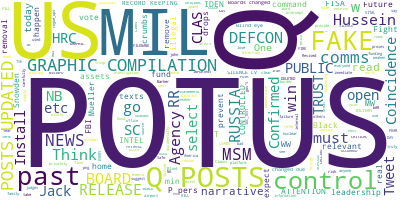
Following claims that the original 4chan board had been infiltrated, the QAnon community then migrated to 8chan, another imageboard. Q attempted to re-establish their authority during this move, confirming a tripcode on the new platform. However, suspicions arose regarding Q’s identity.
The whistleblower Edward Snowden, whose initial role in the theory is controversial, is accused by Q of being a CIA plant in the NSA, with the CIA allegedly a tool of the corrupt cabal.
Meanwhile in the outside world, the US government entered a 35-day shutdown, while Special Counsel Robert Mueller led an investigation into possible collusion between Russia and the Trump campaign during the 2016 presidential election. Both issues affect the topics of Q drops.
This month, Q coins the slogan “Where we go one, we go all”. It will become a major rallying cry for followers of the QAnon conspiracy.
Perhaps unsurprisingly, Robert Mueller and his activities were a key topic in the month’s Q drops. Fake news, Russia, and Attorney General Rod Rosenstein also featured prominently.
February to March 2018
323 Q drops
This period saw Q’s first mention of the name “Operation Merlin”, referring to the aforementioned plot by the Obama administration to send technology to Iran and North Korea. Here, Q alleged that as part of the operation, the US authorities also sent flights carrying billions of dollars in payoffs to puppets of a shadowy global cabal.

Q also declared that cell towers, phones and Amazon Alexa and Google Home smart speakers are capable of “voice to skull” technology, emitting frequencies which implant thoughts and compel people nearby to take certain actions. Blackberry, Q continued, was destroyed by the “global cabal” for not complying with these goals.
Edward Snowden also re-emerged as a central figure of interest in Q’s lore. Q claims that the CIA uses computer games to send coded orders for illegal operations to rogue operatives such as Snowden and John Perry Barlow.
Big tech companies (namely Facebook, Twitter, Amazon and Google) take the spotlight in this period’s Q drops, followed by Edward Snowden, the CIA, and the question of Russian interference on US politics.
April to May 2018
450 Q drops
Q continued to focus on “deep state” collusion with foreign powers, claiming that these shadowy powers had mined uranium in Syria to sell to Iran, covering up the deals by blaming the Russians. As the nuclear deal with Iran came to an end, Q drops considered whether Iran was continuing work on a nuclear facility in northern Syria.

Amid continuing discussions on race and racism in the USA, Q made an appeal to Black voters, increasingly stating that Black communities were ideologically enslaved by the Democratic Party.
On April 3, Q first uses WWG1WGA, the acronym for the slogan “Where we go one, we go all”. Much like the phrase itself, it will become common among QAnon followers.
Q’s tripcode password was leaked, allowing several QAnon followers to post from the account. A new tripcode for Q was then whitelisted and accepted by followers.
Alongside their focus on Syria and uranium deals during this period, Q drops started to draw attention to the convicted sex offender Jeffrey Epstein.
June to July 2018
352 Q drops
On June 16, Q released a “hit list” of 101 reporters who allegedly “colluded with the DNC [Democratic National Committee] during the 2016 election”. Q drops later accused the British government of having worked with Barack Obama in order to sabotage the same election.
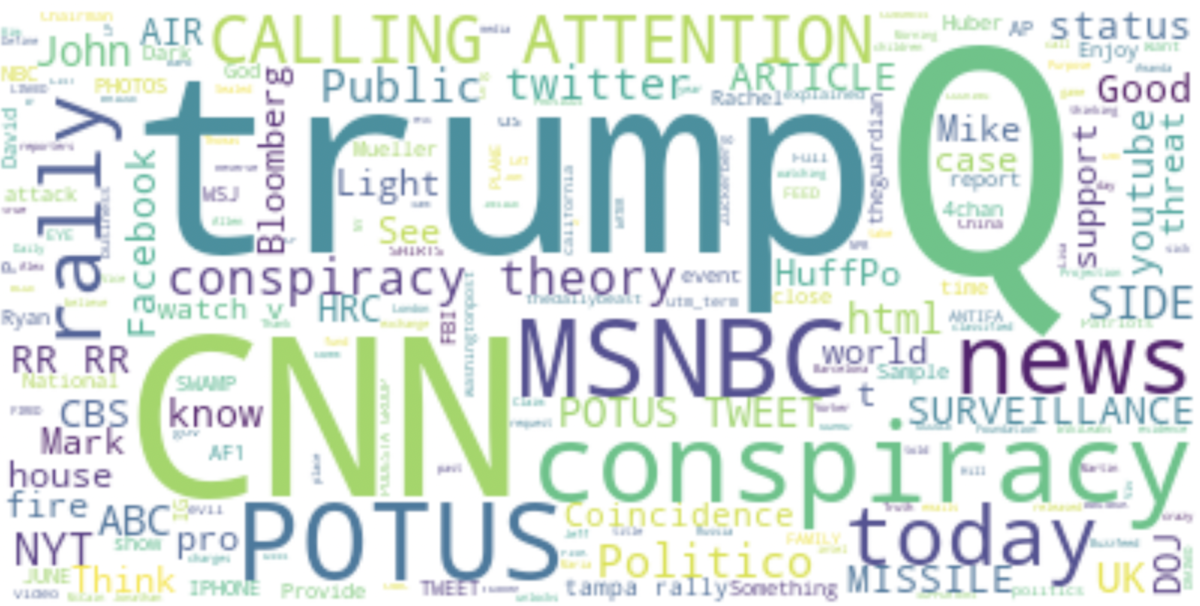
Following Epstein’s arrest on July 6, Q drops discussed the sex trafficking crimes which Q insisted continued to be committed by the cabal. Several drops attempted to connect Bill and Hillary Clinton to Epstein, as well as other traffickers such as Allison Mack.
Q zealously followed discussions around the possible impeachment of Donald Trump and the activities of Special Counsel Robert Mueller. Key topics of interest in all Q drops over this period were fake news and “MSM”, the UK and London, and sex trafficking.
August to September 2018
517 Q drops
This period appeared to be a major call to action to QAnon followers. Many of the Q drops focused on awakening from the “fake news media” with the urge to be “sheep no more” and spark a “grand awakening”.
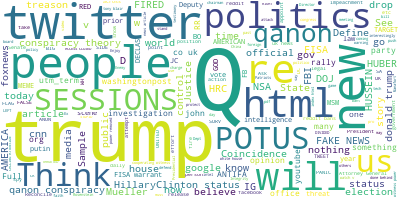
Q drops struck a strongly political tone in August and September, repeatedly encouraging followers to vote in the US midterm elections in order to secure a “red October” (meaning a Republican landslide).
The controversy over the confirmation of Brett Kavanaugh as an Associate Justice of the US Supreme Court was denounced by Q as an example of “liberal left lunacy”. Q also accused bot accounts and hired trolls of downvoting QAnon-related posts on discussion boards.
The “red October”, Kavanaugh confirmation, “fake news”, and allegations of Twitter censorship were all leading topics in Q drops over this period.
October to December 2018
341 Q drops
As the US held midterm elections, online allegations of electoral fraud foreshadowed the same approach the Trump campaign would take in the 2020 presidential election. QAnon conspiracy theorists accused the Democratic Party of filling out “blank ballots” or destroying legal ones, and organising non-citizen voting.
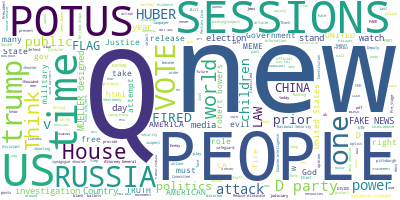
Here Q coined the term “Scaramucci play”, referring to a theory that the White House Director of Communications Anthony Scaramucci had been hired temporarily to remove “untrustworthy staffers” such as the White House’s Press Secretary Sean Spicer and Chief of Staff Reince Priebus.
Electoral fraud was the most mentioned topic in Q drops throughout this period, alongside alleged corruption in the Democratic Party and Department of Justice. Q also paid particular attention to the Senate Judiciary Committee’s hearings on the nomination of Brett Kavanaugh.
January – March 2019
668 Q drops
After Trump’s unsubstantiated claims that Obama had wiretapped his election campaign in 2016, Q raised the alarm about “spygate” and accused Obama once again of betraying the USA. In September 2019, the Justice Department would confirm that neither it nor the FBI had any evidence that Trump Tower had been the target of surveillance efforts by the Obama administration.
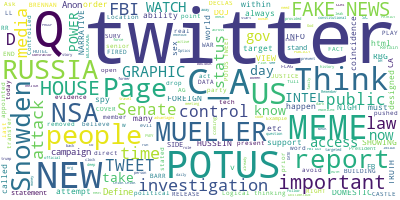
During this period, one of Q’s most lurid claims surfaced — namely that Ruth Bader Ginsburg (referred to in Q drops as “RBG”) was a member of the occult due to her association with the Clintons (Bader Ginsburg was nominated as an Associate Justice to the Supreme Court by Bill Clinton in 1993).
The White House was plunged into chaos after Trump dismissed FBI Director James Comey on May 9. Responding to these events, Q accused Rod Rosenstein of secretly recording Trump in the White House with a view to “entrap” the president. Q then questioned Rosenstein’s connections with the Democratic Party and the “extreme left”.
Key topics of Q’s interest in this period included the Mueller trials, Edward Snowden and Ruth Bader Ginsburg.
April to June 2019
42 Q drops
The Mueller report into Russian interference in the 2016 presidential election was published in April. Until its release, the report into Russian interference in the 2016 presidential election was interpreted by some QAnon believers as part of an attempt to expose the supposed global cabal. Once again, they were disappointed — so Q muddied the waters.

With the report made public, Q suggests that it was not the endgame in the struggle against this cabal, but the beginning of yet another. This heralds the reappearance of DECLAS — a term Q had first used in November 2017 to refer to an undetermined future point where documents exposing the truth about the cabal will all be declassified.
July – August 1 2019
218 Q drops
Q finds another target: Planned Parenthood. Q’s drops claim that the organisation, which offers access to abortion in the USA, is a conspiracy “having nothing to do with a woman’s right to choose,” whose purpose is to harvest fetuses for profit.
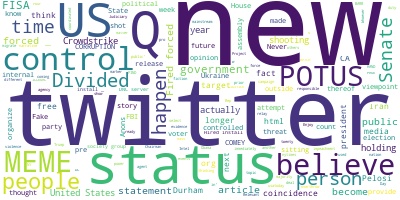
Meanwhile Trump continued to denounce Obama, claiming that he had attempted to call Kim Jong-Un multiple times to “beg” for a meeting, but the North Korean leader did not respond. In doing so, the president compared his predecessor’s record with his own supposed success — Trump met Kim Jong-Un at a summit in Hanoi in February.
A Q drop from this period suggests a similar fixation on the supposed failings of Trump’s predecessor, with the words “Would you believe Hussein tried to call Kim prior to the Summit? He did not have his updated phone number.”
Key topics of interest in Q drops for this period include the investigation into Russian interference, child trafficking and Jeffrey Epstein.
August 2 – November 10 2019
No Q drops
After three shootings in August 2019 in which the attackers used 8chan to spread their hateful manifestos, the website was taken offline that same month. No Q drops appeared during this time period until a transition was facilitated to 8kun, a rebranded version of the site which was launched in November.
November 11 – December 2019
204 Q drops
Q’s interest in “spygate” returned. “Never has a president left office to collude with others to impede the next sitting president of the United States of America until Obama!” declared one Q drop.
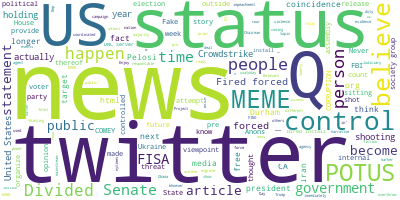
Discussions about Jeffrey Epstein and child trafficking grew in prominence.
Key topics throughout this period included spygate, fake news, attempts to impeach Trump, and Antifa.
January – April 2020
265 Q drops
The first case of COVID-19 was confirmed in the USA on January 20; Trump declared a public health emergency on January 31.
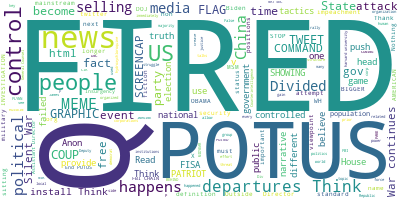
In March, Trump misinformed the public that hydroxychloroquine could be effective in treating or preventing COVID-19. Q followed suit and implied that the medication, which is used to prevent malaria, can also be a cure for the new coronavirus. “What if a cure already exists?” asked Q in one drop, before suggesting that the Democrats are attempting to suppress it.
Q also perpetuated accusations that Democratic governors forced infected COVID-19 patients into nursing homes, thereby deliberately causing the majority of the country’s COVID-19 deaths at the time. Perhaps surprisingly, Q’s first mention of the term “COVID-19” only appeared on April 8.
Key topics in this period were the COVID-19 pandemic and Attorney General William Barr. As a staunch supporter of Trump, Barr defended the president’s decision in April to fire Michael Atkinson, Inspector General of the US Intelligence Community.
The phrase WWG1WGA frequently appeared in Q drops during this period.
May – July 2020
581 Q drops
As the USA looked toward the November presidential election, Trump supporters continued to peddle conspiracies about the Democratic Party preparing for massive voter fraud. Accordingly, QAnon followers and Q drops alike relayed the same messages.
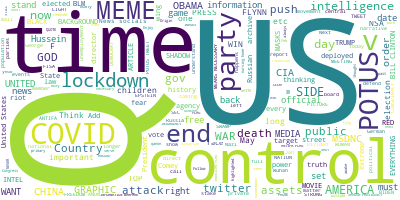
Q drops then refocused on Epstein. One of them included a photo of Ghislaine Maxwell, the British socialite who was arrested on July 2 for her complicity in Epstein’s crimes. Multiple Q drops included photos of Bill Clinton alongside Jeffrey Epstein, followed by more familiar conspiracy theories about the Clintons operating a child trafficking ring.
Subsequent drops accused all five presidents before Trump of colluding with the “deep state”, then turned their attention to Trump’s Democratic challenger Joe Biden. Q also shared thoughts about the protests which rocked the country following the killing of George Floyd by Minneapolis police. Q focused commentary on Antifa’s presumed role in the demonstrations, even quoting and reposting Fox News articles describing Antifa as an “anarchist, left-wing outlet”.
Key topics mentioned during this period included mail voting, election fraud, Ghislaine Maxwell, the Clintons, and the COVID-19 pandemic.
August – September 2020
179 Q drops
The Republican and Democratic Parties both held their national conventions in August, during which Trump and Biden were chosen as their respective presidential candidates. On August 20, Trump was asked his opinion of the QAnon movement during a press conference. The president stated that he knew little about the conspiracy theory but acknowledged that “they like me very much”.

Amid growing polarisation about the upcoming presidential election, Q continued to fulminate against Antifa, comparing it to the militant anti-fascists of the interwar German communist party. Q drops also compared Democrats’ usage of social media to the propaganda of Nazi Germany. The fractious atmosphere before the election also lead to more media attention towards QAnon — to which both Q and followers reacted very negatively.
Key topics in this period included Antifa, child trafficking and sex criminals, and the word “MSDNC”. The latter, a portmanteau of the cable TV channel MSNBC and the acronym for the Democratic National Committee, was used in Q drops denouncing fake news.
October 2020
148 Q drops
After it had generated rising media coverage and notoriety, Trump was asked if he would denounce QAnon during an interview with the NBC’s Savannah Guthrie. Trump reacted defensively and refused to explicitly disavow the conspiracy, saying “I don’t know about QAnon”.

In a single month, Q shared over 30 articles about Hunter Biden from right-wing news outlets such as Fox News and Breitbart. Since 2019, Hunter had been accused by Trump and his supporters of corruption due to his business dealings in Ukraine while his father Joe Biden was Vice President.
Otherwise, this may have been a month of déjà vu for Q’s followers. Drops earlier in the month refocused on the Clinton Foundation, accusing the Clintons of bribing politicians in Washington D.C. With another election around the corner, Q came full circle to the conspiracy’s first fixation:

Q’s penultimate drop in October read simply “are you ready to take back control of this Country”, implying that the election was not merely a referendum against the Democrats, but against a global cabal of bad actors which still reigned:

Key topics of Q drops during this period included Joe Biden, Hunter Biden, and the Democratic Party.
What next?
Since the US election in November 2020, the rate of Q drops has sharply declined. Only a single drop appeared in the last two months of 2020, on December 8. Recent crackdowns on QAnon accounts across social media, and the inauguration of President Joe Biden, have dealt further blows to the conspiracy.
At the time of publication, there have been no confirmed Q drops in 2021. But it’s far too early to catalogue the conspiracy as history. As demonstrated repeatedly in our timeline, QAnon is extremely adept at adapting to contradictions and challenges.
The conspiracy has weathered both homelessness on the internet (the 8chan shutdown and 4chan migration) and longer freezes in Q drops (101 days from August to November 2019) before.
It may yet survive.
Acknowledgements
Special thanks to William Thompson, and Johanna Wild and Logan Williams from the Bellingcat Tech Team for their assistance on this investigation.

